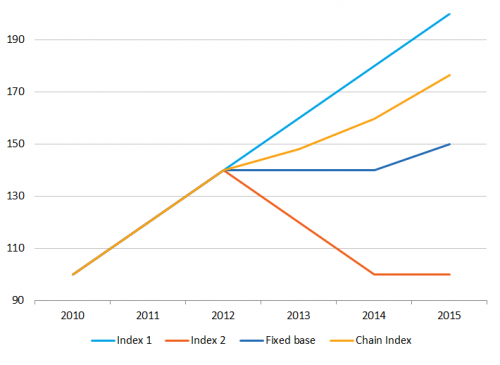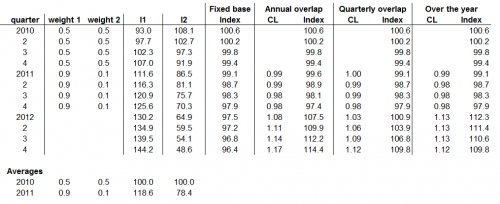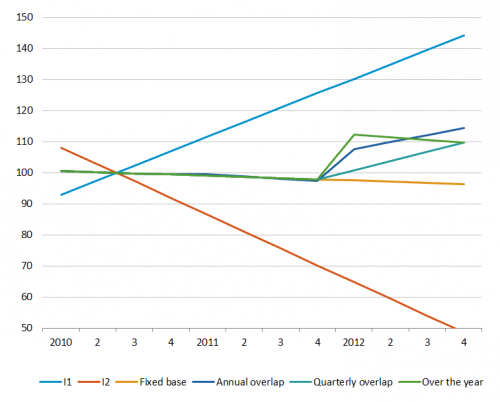Short-term business statistics and (annual) chain linking
This article is part of a set of background articles treating various methodological aspects of short-term business statistics.
In short-term business statistics higher level indices are constructed by summing up weighted lower level indices; the weights of the lower level indices reflect the economic structure. For example, the total industrial production index is the sum of the weighted indices for the various industrial sectors (mining, manufacturing, energy) and the weights reflect the different importance of the industrial sector. Similarly, the European indices are constructed by weighing together country indices, the weights reflect the different sizes of the countries (see article on index compilation and on base year change).
If the weights used for the index compilation are kept constant over a longer period (fixed base indices) the real economic structure will over time move away from the structure represented by the weights. Therefore Regulation 2020/1197 implementing the European Business Statistics Regulation requires (in annex VII) that the Member States update the weights for STS indices "at least every five years" (see article on base year change). Short-term business indices and corresponding growth rates published by Eurostat for the EU and for the euro area are such fixed base indices for which the weights are changed every five years. Some Member States however update the weights (at least for some indices) more often and use an annual chain linking methodology to create time series of the different weighted indices. This article describes the basic concept of annual chain linking and outlines the recommendations from the Eurostat expert group on annual chain linking.
Full article
The basic concept
The practice of annual chain linking is illustrated by a simple example (Table 1). In addition to the weights for the base years 2010, weights are also provided for the years 2011 to 2014. Figure 1 shows the indices which are combined, the fixed base and the chained result.
The fixed base year index uses only the weights from 2010. For example, for 2014 the fixed base year index is calculated by:
(0.5 * 180 + 0.5 * 100) / (0.5 * 100 + 0.5 *100) = 140.
The annual chained index updates the weights every year. For the comparison between 2010 and 2011 the weights from 2010 are used, for the comparison between 2012 and 2013 weights from 2012 are used and so on. Each year is compared with the previous year on the basis of weights which are just one year old.
The link between 2013 and 2014 is for example calculated as follows:
(0.8 * 180 + 0.2 * 100) / (0.8 * 160 + 0.2 * 120) = 1.08
This linking factor is then applied to the index for 2013 to yield the index for 2014:
1.08 * 148.0 = 159.7
Unlike a fixed base year index, a chained index series has no particular base year. Each index value is produced on the basis of the actual chain link and the previous index which is again produced by a chain link and the index before etc. So the index value (I) for a year t is produced by
It = CLt * CLt-1 * CLt-2 * CLt-3 * CLt-4 * It-5
where CL are the chain links. The chain ends with the reference year (e.g. t-5) for which the index value is set, by convention, to 100. The reference period can be changed by simply dividing the index series with its level in any period chosen as the new reference period. Changing the reference period simply consists of a rescaling practice and can be done at any time. The rescaling coefficient is simply the arithmetic mean of the 12-monthly/4-quarterly indices in the year of the new reference period. The rescaling does not affect either the month-to-month/quarter-to-quarter index rate of change or the 12-month/4-quarter index rate of change. The annual chained index can be easily re-referenced to 100 in the reference year, by dividing all index values through the index value of the corresponding reference year.
Laspeyres and Paasche-typ indices
Note that the above example describes a Laspeyres-typ index. The chain link between period t and the previous period t-1 (denoted by CL(t-1)→t is produced on the basis of weights from period t-1 (i.e. w1,t-1 and w2,t-1):
Laspeyres CL(t-1)→t = (w1,t-1 * I1,t + w2,t-1 * I2,t) / (w1,t-1 * I1,t-1 + w2,t-1 * I2,t-1)
The comparison could also be made on the basis of the current weights, i.e. the years 2011 and 2010 would be compared on the basis of the weights from 2011. The indices would then be of a Paasche-typ. The general formula for the combination of a Paasche-typ chain linked index from just two basic indices is:
Paasche CL(t-1)→t = (w1,t * I1,t + w2,t * I2,t) / (w1,t * I1,t-1 + w2,t * I2,t-1)
The weights in the Paasche-formula all refer to period t (i.e. w1,t and w2,t). Paasche-typ indices are however not convenient in practice, in particular because the weights are usually only available with a certain delay. In what follows, only Laspeyres-typ indices will be discussed.
The above formulae are simplified since they only combine two indices. Generally the indices that have to be combined are more numerous and thus the general formula for a (Laspeyres-typ) chain index with n sub-indices is:
CL(t-1)→t = ∑ wi,t-1 * Ii,t / ∑ wi,t-1 * Ii,t-1 where ∑ sums over the indices i from 1 to n.
Monthly and quarterly indices
Short-term business statistics provide data (e.g. on the production volume, turnover, prices) on a monthly or a quarterly basis (annual STS data are just the averages from the original monthly and quarterly data). The weights for the STS indices are generally however only available on an annual basis (e.g. from structural business statistics). There are three different methods to combine the monthly and quarterly STS data with the annual weights in chain linking:
- Annual overlap
- One-quarter/one-month (December) overlap
- Over-the-year method
In the following; only the chaining of quarterly data is discussed for the sake of simplicity. For monthly data the methods are applied in a similar way.
Annual overlap method
In the annual overlap method, the indices for a certain quarter (e.g. Q1 2011) are weighted with their (annual/average) weights of the previous year and set in relation to the weighted annual average Indices of the previous year:
CLt,q = ∑ wi,t-1 * Ii,t,q / ∑ wi,t-1 * Ii,t-1
The index for year t and quarter q is produced by multiplying the chain link (CL) with the corresponding quarterly index of the previous year: It,q = CLt,q * It-1
One-quarter overlap method
In the one-quarter overlap method, the indices for a certain quarter are also weighted with their (annual/average) weights of the previous year but are set in relation to the weighted last quarter of the previous year. For obtaining an index this chain link is multiplied with the index for the last quarter of the previous year:
CLt,q = ∑ wi,t-1 * Ii,t q / ∑ wi,t-1 * Ii,t-1,4
It,q = CLt,q * It-1,4
Over-the-year method
In the over-the-year method, the indices for a certain quarter are also weighted with their (annual/average) weights of the previous year but are set in relation to the corresponding weighted quarter of the previous year. The index is calculated by multiplying this chain link with the corresponding quarter of the previous year:
CLt,q = ∑ wi,t-1 * Ii,t q / ∑ wi,t-1 * Ii,t-1,q
It,q = CLt,q * It-1,q
A comparison of the formulas shows that the nominators of the three chain links are identical but the denominators are different: In the annual overlap method the annual averages of the indices of the previous year are used, in the one-quarter overlap method only the indices of the last quarter of the previous year are used, and in the over-the-year method the indices of the current year are set in relation to the corresponding indices of the previous year.
In the annual overlap method and in the over the year method, each quarter is chained to the corresponding quarter of the previous year; in the one-quarter overlap method all indices are chained to the last quarter of the previous year.
Table 2 provides an example for the different methods in which two indices (I1 and I2) are combined. To solve the starting year issue for the annual chain linked indices, the chain linked indices are set equal to the fixed base year index in the starting year 2010 which is also the reference year. Figure 2 shows the graphs of the corresponding indices.
All methods have advantages and disadvantages. The fixed base year index does not take into account the most recent changes in the economic structure. The main short-coming of the over-the-year method is that it does not really produce one chained index but four – one for each quarter – and these four indices for one year are rather unconnected. The main disadvantage of the annual overlap method is that it will result in shifts of the chained index for each first quarter of a year, i.e. when the weights are changed. The one-quarter overlap method produces a satisfactory chained index, the disadvantage is however that the quarterly indices do not correspond to the annual index.
Recommendations of the Eurostat Task Force "Chain linking"
Between 2010 and 2012 a task force of experts from National Statistical Institutes, the OECD and the ECB chaired by Eurostat analysed the different annual chain linking methods and formulated a number of recommendations:
- Annual chained STS indices should be used for volume and price indicators (but not for nominal indicators, i.e. turnover) in areas where the economic structure develops fast.
- For volume indices the annual overlap method should be used.
- For price indices, the one-month overlap method should be used for the monthly industrial producer prices and monthly industrial import prices and the one-quarter overlap method for the quarterly construction producer prices and service producer prices. The overlap period should be December or the fourth quarter respectively.
Considering the relatively high costs of annual chain linking, Member States are not obliged to use this method, but if they do, they are strongly advised to follow the task force's recommendations in order to avoid incomparable results.
Direct access to



